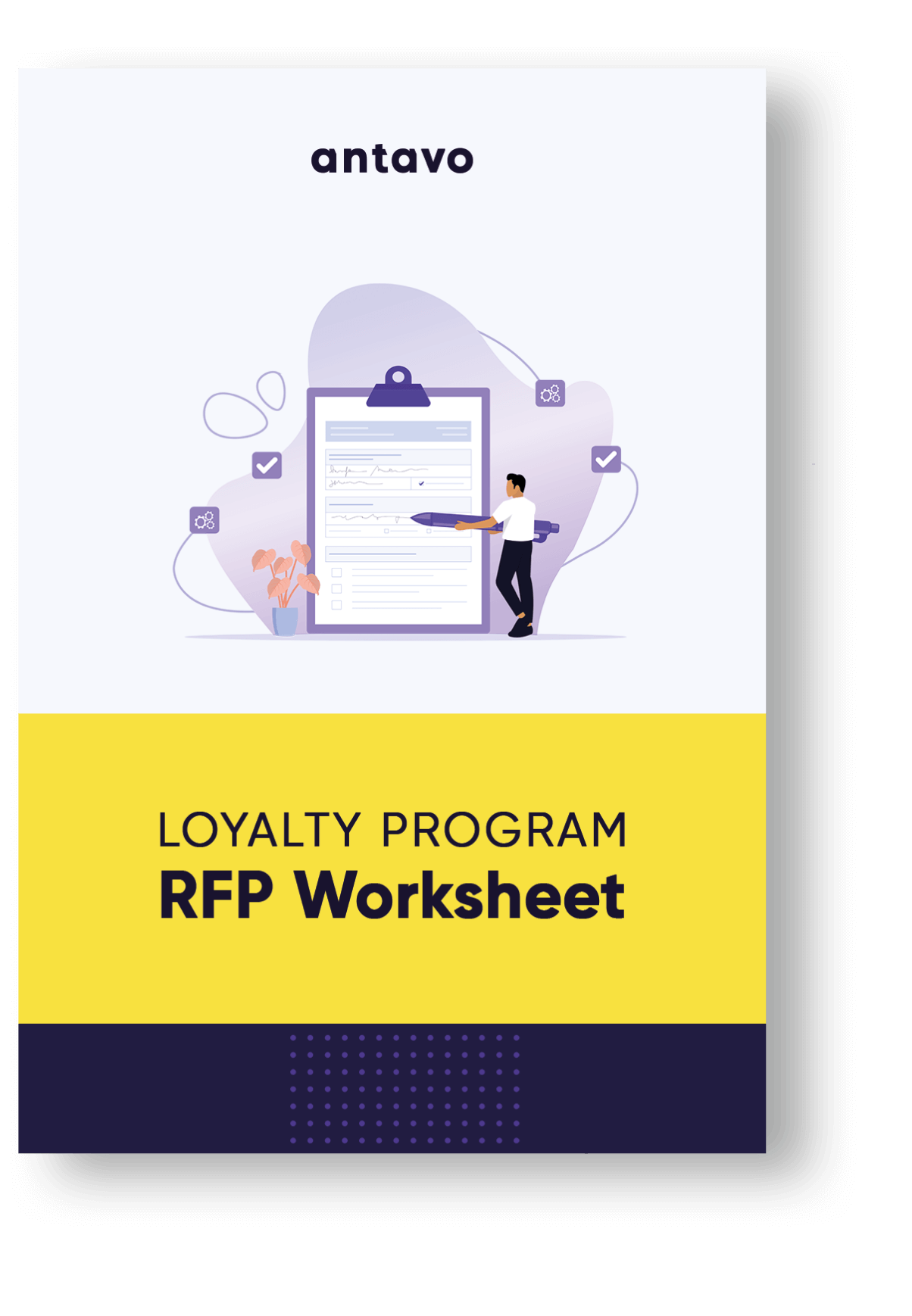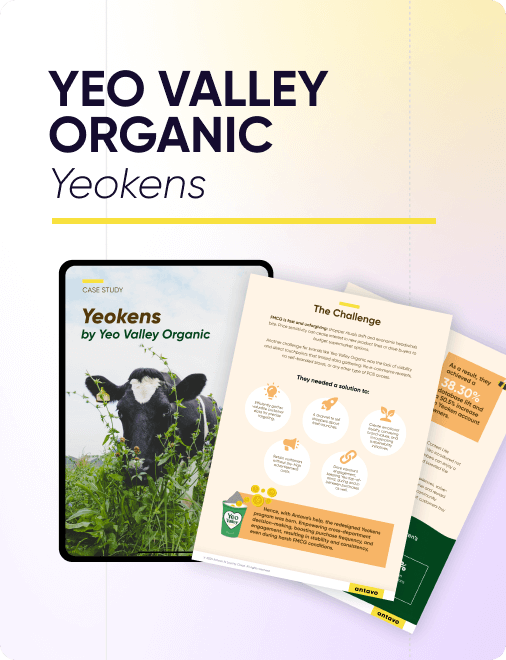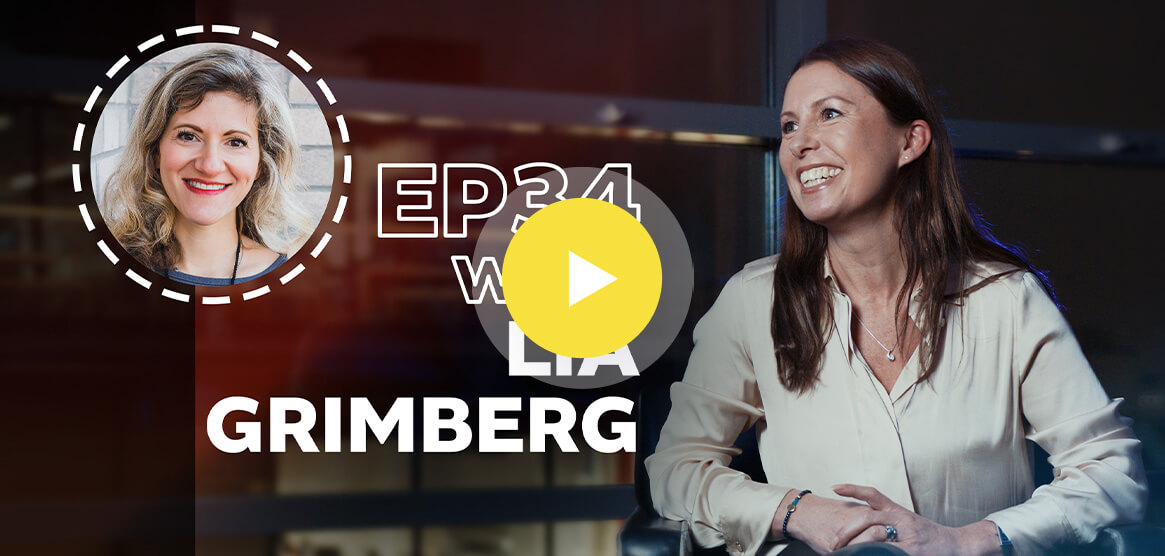During this week’s episode of Antavo’s Loyalty Stories video podcast, our expert guest is Lia Grimberg, Principal and Consultant at Radicle Loyalty.
The interview for this podcast has been a valuable source for Antavo’s Global Customer Loyalty Report 2024. Make sure to download it for over 30 statistics on loyalty program trends.
This time, we explore key trends in customer loyalty and the impact of partnerships. Lia shares her insights on brands with successful loyalty programs like Beauty Insider from Sephora and the evolving expectations of consumers in today’s market. We also cover the future of loyalty programs, and how brands can better connect with their customers.
Highlights from our conversation with Lia:
- Ongoing trends in emotional loyalty
- Regional differences of Middle Eastern and Western countries in loyalty programs
- Challenges in the industry of loyalty
- Her meaningful advice for young loyalty professionals
Learn more:
- LinkedIn profile of Lia Grimberg
- Radicle Loyalty website
- Check out our guide on omnichannel loyalty programs
- Book a demo with Antavo’s loyalty experts
Michelle
Hi, and welcome to Loyalty Stories, Antavo’s podcast on loyalty campaigns. I’m Michelle Ellicott-Taylor, and I am the Head of the Global Partnership Team at Antavo. And we’re a technology vendor that powers loyalty programs all over the world. And we work with great businesses like KFC and Benefit Cosmetics. Lots of fashion companies, automotive, airports, and so on. It’s a great variety we’re working with.
In this podcast, Loyalty Stories, we’re diving into the trends around customer loyalty and loyalty programs, and we get to speak to some experts in this field. So I’m really excited today to introduce Lia Grimberg from Radicle. Lia, thank you so much for joining us today.
Lia
Pleasure to speak with you. Thank you so much.
Michelle
No, it’s really great to have you on board and to find out more about what you’ve got to share from your insights and expertise in regards to loyalty. But before we get started, do you want to share a little bit more about your background?
Lia
Of course. So I just recently opened my own shop called Radicle Loyalty, where we help organizations design and redesign loyalty programs and leverage them to drive better relationships with their customers. Prior to that, I have over 20 years of experience in loyalty, both on the client side and on the consulting side, in primarily retail and financial services institutions.
Michelle
Well, that sounds really exciting. So we’re going to hear a lot of your insights today. And I guess a good way to get started is you sharing some thoughts on your favourite loyalty programmes, because that’s what gets everyone excited hearing about from loyalty consultants. So can you tell us a bit more about who’s excited you in the loyalty space and why?
Lia
I’d say probably the top one is a cliche one. Sephora, Beauty Insider has been a long time favorite, both as a consumer and a loyalty specialist and a loyalty expert. They do a wonderful job in terms of the benefits, covering the gamut from hard benefits in terms of points and in terms of tiers.
But also creating specific bonds and community access. So by an example, they allow creation from a content perspective. So I can go online and I can ask a question of how do you contour a face? And somebody unknown will jump on and create a video of exactly how to do that.
We don’t necessarily know each other, but now we’re collaborating to create something that’s novel. And she’s also helping me solve my problem, which a lot of organizations and loyalty programs only focus on tiers and points and more the hard benefits, but truly driving loyalty from a retention and existing customer perspective are those softer tactics that allow people to connect, that allow people to come together and that allow people to create something that makes a world a better place or us better people as it were.
And they even recently came out with a new tactic from a gamification perspective, targeted at Gen Z in the sense that they allow non-transactional behavior earn, but they’re putting them together as challenges. So it becomes different tasks that you as a consumer have to complete before you’ll be able to unlock a reward. And I personally love that.
Michelle
Yeah, I think the Sephora one is a very popular and well-known one, isn’t it? So that’s a great reference there. And I guess, like you mentioned already about your great experience in this space. So what about with a brand that you’ve actually worked with? So who would you, and maybe there’s a couple, but yeah, who would you like to, I guess, share more with our audience about, yeah, those brands?
Lia
Yes, so I was part of Loblaw, which is Canada’s largest grocery store. And PC Optimum is one of the iconic Canadian loyalty programs. And it spans the grocery and the pharmacy business. But the lovely thing about it is the personalization aspect of it and the user customer experience in the app.
The personalization is really about offers. Loblaw being the predominant grocer has a wealth of data, obviously, on the majority of Canadians. And so by compiling everything that they know about you, they’re able to create product-specific, SKU-specific, brand-specific, or whole store offers that are so incredibly relevant that allows customers to earn and get to redeem fairly quickly. And there’s an accelerator also with a credit card as well as banking products.
Michelle
That’s interesting when you’re looking at the wider collaboration that people are doing with their loyalty programmes and what other benefits there are outside of the pure direct brand there.
Lia
Exactly. And the fact that a lot of brands are getting into partnership nowadays. And so the fact that Loblaw has also a partnership with it with a gas station. Again, one of the largest gas providers in Canada, covers that whole high frequency retail gamut from grocery to drugstores to gas.
Michelle
Yeah, I think that’s been something that we found with our actual survey that we’ve been sharing, that there’s a lot of people very interested in looking at the partnerships and collaborations that are going on and how that creates a stronger value proposition to the end customer, doesn’t it? Because all those touch points are being joined together for them to benefit from.
Lia
Exactly. I mean, one of the consumers, one of the biggest metrics that we look at to compare, we’re comparing loyalty programs is the dividend, what’s the value that we’re getting. But on the other hand, time to reward is also a very important component. And having credit card accelerators and high frequency details and high frequency ways to earn gets you a reward. So do something meaningful much faster.
Michelle
Yeah, I think you mentioned earlier about Gen Z, like a lot of people, I guess, in that group, they don’t want to be waiting, you know, they want an immediacy on that reward, don’t they? Great. Okay. And then thinking about the last couple of years, what would you say you’ve seen that are changes in the loyalty industry on how people have been working now?
Lia
Yeah, so most recently I’ve seen one unfortunate trend, which is the devaluation of benefits of loyalty programs. And that’s through either devaluing rewards, making them more expensive or changing the way that you earn, taking away or making more restrictions around birthday gifts and Starbucks and Sephora and Delta have all been kind of guilty of all three.
Part of it is our economic reality. But customers are looking for value in their loyalty programs. And so unfortunately, that’s going in the converse direction, and then offering more value, it’s now offering less, which makes the investment in the customer and the customer relationship feel less important to the organization.
But then on the flip side, as I mentioned earlier, we’re seeing a lot more partnerships, both long term and short term partnerships, which does go in the benefit of the customer. And then personally, I’m glad to see a lot more personalization and better data usage.
Michelle
Yeah, personalisation is a big theme here and it’s not just sort of the basics of personalisation but obviously it’s all about that targeted content and the rewards you’re giving against that person rather than as a generic offer.
Lia
Because we have the data, we have the tools, we have the know-how, and there’s really simply no reason not to do it, and the customer expects us to use it.
Michelle
Yeah, yeah, that’s it. A customer’s got a higher expectation now, haven’t they, on how they’ll be treated because so many brands are doing it so well.
Lia
Exactly. And not everyone is doing it. Well, there are still false moves and wrong moves, but at least we’re starting finally to move in the right direction. And I think generative AI should help with all of that.
Michelle
Definitely. And looking at, I guess, we looked at the changes that have happened over the last couple of years, but what do you see as trends that are going to be coming up over the next, I guess, one to two years in the loyalty industry?
Lia
So I’d say cause marketing, so ESG related loyalty initiatives is one trend that I’m happy to see. And then the second one is emotional loyalty. So less transactional and more deeper connection and really rewarding people for who they are, for what they do and helping them be better self.
Michelle
Yeah, I think there’s a very big trend on the emotional loyalty side, isn’t there? And when you say about ESG and things, what are people doing with sustainability? What is the different value that they value exchange that they have rather than the pure earn and burn, which obviously works. You know, the point system works very well with some industries, but with others, there’s definitely a move towards what they can be doing on the more emotional, loyalty and non-transactional side.
Lia
And some are dipping their toes and allowing customers to just donate their points to the charitable organizations, but some are truly embracing it and making it part of the overall brand as well as the loyalty value proposition. And it’s refreshing to see because people are now shopping with their hearts as well as their wallets. And so being on the same page and working towards a common goal with your customer makes for that truly emotional connection rather than just transaction.
Michelle
Yeah, exactly. I think we’re definitely going to be seeing those emerging over the next couple of years and being in line with the charitable side of things and that giving back mentality. I think that’s really important.
Great, okay. And then I guess, obviously these are really important things that you’re thinking about when you’re designing concepts and things with a brand, but obviously you and the end customer have to think about the loyalty platform that’s going to be supporting that. So when you’re thinking about that, are you looking at things that are important like the integration, implementation, ease of use? Is it about whether it’s omni-channel? What are the key things with a platform that you’re seeing are important?
Lia
Absolutely omni-channel, no coding, but the biggest struggle that I find my clients are having is with respect to unification of data and data visualization. And the fact that there are so many silos and not a single view of the customer, regardless whether they’re a loyalty member or not. And the fact that they have different data visualization platforms that may or may not give the same level of data or the same potentially view of what’s going on.
And so it’s important to be able to have the same information across all the different lines of business to be able to help decision making. And then also not to be able to have to look at four different places to get the full picture of what’s going on. The other major challenge is the process from the point of data to the point of communication.
Again, regardless of whether customers are loyalty members or not, it’s to be able to create the same message and at the same time and across all the channels. So that regardless of the touchpoint of interaction of the customer, they see the same offer, the same content, the same product recommendations, and that experience is seamless. And again, part of that is data. And then part of it is the actual process of integration.
Michelle
Yeah, data, well being data-led is very important now because people are sharing so much of that. So it’s very difficult for a brand to justify why they’re not using that data to inform and bring, like you say, all that data together rather than having it siloed off. You don’t want the same brand targeting somebody with the wrong messaging when they haven’t brought all that data together.
Lia
And there’s nothing more frustrating than for a frontline employee to be faced with a customer that has different information than what they see or a different offer than what they see. And there’s nothing more frustrating for a customer to be followed with a product that’s around that they’ve already bought and retargeting often is guilty of doing that, particularly when the price drops and then but it triggers buyers remorse which is not the best situation that you want to be putting your best one in.
Michelle
Yeah, exactly. And you mentioned already, obviously, with the brands that you’ve been working with and being Canada based. And I wanted to ask you a bit about what you see from, I guess, different aspects and regionally of how different loyalty programs might work. So, like, are you purely working with brands in that region? And on a wider remit, yeah, do you see from an international, I guess, overview what works in different places?
Lia
Yeah, so Canada, going back probably 20, 30 years, was the grandparent of coalition loyalty programs. So AirMiles was one of the very, very first to be a third party to bring a lot of different sponsors across primarily retail to non-traditional airline-based companies together to form a coalition.
Now, fast forwarding to today, what we’re seeing is that coalitions are struggling a little bit in Canada. New partnerships are popping up, but not quite in the same vein. Coalitions never ever took off in the States. The market is very different from Canada in the sense that it’s a much larger market, but there’s a lot more frontalization of retail. We have large national grocers, they have much smaller regional players. And to get a nationwide program never actually worked.
Whereas Europe with respect to coalition loyalty has embraced it and has done really well with it as did Australia and APAC. And now I think the Middle East has these large conglomerates that are not quite coalition programs in and of themselves that are starting to come forward with these coalitions. And I think that Canada has a lot to teach from an experience perspective of what worked and what didn’t. And we have certainly a lot of lessons learned.
Michelle
Yeah, I think it’s really interesting referencing it starting in Canada. Air Mars is something that so many people are aware of. It’s been around a long time, but it’s interesting that it doesn’t necessarily, that type of program doesn’t necessarily work in other regions.
Lia
No, no, I think there are certain imperatives that need to be in place in order to work successfully. And now, CLOs and card linked offers are popping up a lot more in Canada that we’re learning from other markets about because it’s a little bit of a later entrance for us.
Michelle
Yeah, and I guess with that in mind, thinking about the types of job titles, like who’s giving you these assignments, like obviously it was very much from a CMO or loyalty marketing team perspective, but now there’s maybe a lot more people involved in making these decisions. So yeah, it’d be interesting to get your viewpoint on that.
Lia
It really depends on the size of the organization. For smaller organizations, you tend to be a lot of the C-Suite, including the CEO and CFO that are involved in the decision making just because it is such a huge financial investment. From a rewards and from a loyalty vendor perspective that they want to have a seat at the table marketing is always at the table. And then again, depending on the size of the organization they may or may not have dedicated loyalty folks and then eventually as they grow up they absolutely build that team up.
Michelle
Yeah, yeah, I think it’s, yeah, it’s more of the board that are looking more now about what’s going on with the loyalty, because they see the value of that. So like you say, with the CFO getting involved and while it might still be led by the marketing team, there’s other eyes on it now. Yeah, okay.
Lia
Exactly. I from growing up on the brand side of the business, your financial partner is a key stakeholder, because you need to make sure that your, your program is ROI positive, and it’s driving the right kind of behavior, and the right kind of results for the organization. Otherwise, unfortunately, your budget will be cut later on.
Michelle
Yes, exactly that. Yes, they need to be on top of that totally. And then thinking about, obviously, you’re mentioning some C level job titles there, but thinking about people who are just maybe starting out in more junior loyalty roles, and obviously, you’ve got some great experience. And it’d be really nice if you could share what you think about someone who’s maybe a junior loyalty manager right now, but is aspiring to be head of loyalty. What are the types of things they need to be aware of to really grow in a role like that?
Lia
That’s an amazing question and I wish I would have thought about that earlier in my career. I’d say one is embrace the data and I went back and I got my post grad in AI and ML and I really wish I would have done that earlier because that would have been incredibly useful in my career to be able to partner better with my analytics teams.
But secondly, it’s about, I think, building relationships across the entire organization. Depending on how ingrained loyalty is in the DNA of the organization, creating allies and really teaching different aspects of the organization, what loyalty data and what loyalty currency can do to inform their aspect of the business and help them make better decisions will make for a better fruitful relationship moving forward.
And it really puts the customer at the center and it makes the decisions that much better. And that goes both internally and then also across the supply chain back to the vendors. So making sure that they truly understand how loyalty impacts their business and truly understand what’s going on from a customer perspective and how they can leverage loyalty to drive their specific objectives.
Michelle
Thank you very much for sharing that. I think it’s such a popular place to go now in the marketing teams with what’s going on with loyalty. It’s very exciting and it’s great that obviously people in that role will be bringing their own insight into it but obviously getting the guidance from experts as well is really important.
Lia
Absolutely. And we’re seeing a much more fragmentalization of the CMO role. It becomes about brand, about growth, and then potentially a third stream of loyalty.
Michelle
Yeah, yeah. Excellent. Okay, well, thank you so much for today. I’ve got one last question for you before I let you go. And I know you’ve already touched on some of the favourite programmes, but as you’ve got such good experience in this space, could you share anything with me about maybe a brand that has surprised you with what they’re doing in loyalty?
Lia
Gosh, surprise me? I don’t know.
Michelle
Yeah. I mean, it could be a surprise and delight or it could be unusual.
Lia
I just recently saw, I actually posted about this. It wasn’t necessarily, it was more of a promotion rather than a specific design. It was by a company called Peet’s Coffee. And what they’ve recently done is they’ve put out a promotion where you can use competitive points to redeem for free coffee at Peet’s. And they’re calling it disloyalty. A disloyalty program.
So it’s an interesting tactic in the sense that they’re driving trial and they’re competing against behemoths like Starbucks and Tim Hortons and Dunkin’ Donuts and it’s hard to shift these embedded clients but at the same time are they attracting the right clients or are they just looking to pick off those fickle customers who are looking potentially to try something new, try something different, and are not truly all that loyal to a competitive brand. So I’m curious to see how that will turn out. To me, it’s not dissimilar to status match in airlines, where that strategy that they use, except that the cost of attrition is much higher in airlines than it is in the coffee business. I’m curious to see whether these customers that they get through trial will stick around in the long term.
Michelle
Yeah, it’ll be interesting to maybe revisit the conversation in six months and see how it’s going and what your thoughts on the programme are then.
Lia
I’m curious to see what kind of success they’ll see and whether they’ll acquire new customers for good or just get them to try and then leave. I suppose it depends on how good their coffee is.
Michelle
Exactly, that’s the main thing, isn’t it? And their choice on milks and things like that. That’s great. It’s something really different to share. So I always like to ask that question. So we always get some little insights there. So yeah, thank you so much for that. It’s been a real pleasure to have you today sharing all your thoughts.
Really lovely to chat with you. Thank you again so much for joining us. And thank you all for watching Antavo Loyalty Stories. Wherever you see this or hear this, please give us a like and please visit antavo.com to hear more about our loyalty platform.
And if you have any questions you’d like to reach out to Lia about at all, I’m sure she’d be happy to hear from you on LinkedIn. But thanks so much again, everybody.










